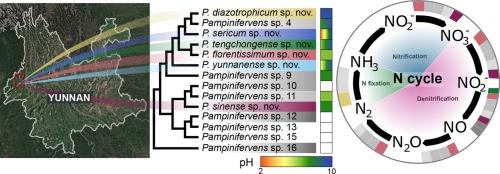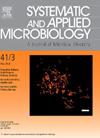水栖科丰富物种的新属Pampinifervens的固氮作用,它栖息在陆地温泉的广泛pH范围内
IF 4.2
2区 生物学
Q2 BIOTECHNOLOGY & APPLIED MICROBIOLOGY
引用次数: 0
摘要
水螅门成员在地热系统的氢、硫和碳循环中发挥着重要作用,是普遍存在的丰富的化能岩石自养生物;然而,它们在氮循环中的作用尚不明确。本研究表明,来自腾冲的水仙花科分离菌T-2T在以二氮为唯一氮源的条件下生长,并在15N2条件下结合15N原子来固定氮。我们进一步证明,它的固氮(nif)基因在附近的泉水中就地转录。我们建议命名为Pampinifervens重氮营养菌gen. et sp. nov.,以菌株T-2T (= JCM 35475T = DSM 116324T)为命名型。其近亲Pampinifervens florentissimum sp. nov. T-8T (= CGMC 1.5214T = JCM 33569T)不固定氮,但呼吸硝酸盐。通过对来自84个宏基因组的104个宏基因组的分析,我们确定了Pampinifervens属,并确定了至少16种同域Pampinifervens种,这些种在中国西南不同温泉中占主导地位,在全球范围内具有独特的物种。对这些Pampinifervens基因组的分析显示,nif和反硝化基因的存在是可变的,并且频繁的基因丢失和水平转移。在Pampinifervens基因组中也存在pH稳态基因,并且在腾冲种中有增殖,这与Pampinifervens分离株的pH生长范围广以及Pampinifervens在碱性和酸性泉中的普遍存在一致。氮化和反硝化基因的动态演化以及pH稳态基因可能促进Pampinifervens向不同氮有效度的多样性多样性。本文章由计算机程序翻译,如有差异,请以英文原文为准。

Nitrogen fixation in Pampinifervens, a new species-rich genus of Aquificaceae that inhabits a wide pH range in terrestrial hot springs
Members of the Aquificota play important roles in hydrogen, sulfur, and carbon cycles in geothermal systems as ubiquitous and abundant chemolithoautotrophs; however, their roles in the nitrogen cycle are poorly defined. Here, we show that Aquificaceae isolate T-2T from Tengchong, China, fixes nitrogen based on growth with dinitrogen as the sole nitrogen source and incorporation of 15N atoms when grown with 15N2. We further show evidence that suggests its nitrogen fixation (nif) genes are transcribed in situ in a nearby spring. We propose the name Pampinifervens diazotrophicum gen. et sp. nov., with strain T-2T (= JCM 35475T = DSM 116324T) as the nomenclatural type. Its close relative designated Pampinifervens florentissimum sp. nov. T-8T (= CGMC 1.5214T = JCM 33569T) does not fix nitrogen but respires nitrate. Analysis of 104 metagenome-assembled genomes from 84 metagenomes allowed us to circumscribe the genus Pampinifervens and identify at least 16 sympatric Pampinifervens species that dominate the Aquificaceae populations in diverse hot springs in southwest China, with distinct species globally. Analysis of these Pampinifervens genomes revealed variable presence of nif and denitrification genes and frequent gene loss and horizontal transfer. Genes for pH homeostasis were also present in Pampinifervens genomes, with a proliferation in species from Tengchong, consistent with the wide pH growth range of both Pampinifervens isolates and the prevalence of Pampinifervens in both alkaline and acidic springs. The dynamic evolution of nif and denitrification genes, along with pH homeostasis genes, may facilitate the diversification of Pampinifervens into diverse springs with different nitrogen availability.
求助全文
通过发布文献求助,成功后即可免费获取论文全文。
去求助
来源期刊

Systematic and applied microbiology
生物-生物工程与应用微生物
CiteScore
7.50
自引率
5.90%
发文量
57
审稿时长
22 days
期刊介绍:
Systematic and Applied Microbiology deals with various aspects of microbial diversity and systematics of prokaryotes. It focuses on Bacteria and Archaea; eukaryotic microorganisms will only be considered in rare cases. The journal perceives a broad understanding of microbial diversity and encourages the submission of manuscripts from the following branches of microbiology:
 求助内容:
求助内容: 应助结果提醒方式:
应助结果提醒方式:


